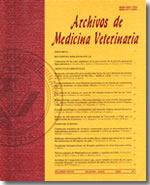Effect of melatonin on the pulsatile luteinizing hormone and growth hormone secretion in ewe lambs under food restriction
Main Article Content
Abstract
The aim of the present work was to characterize the pulsatile LH and GH secretion in food restricted Suffolk ewe lambs (n=5, R-MEL group) receiving daily oral administration of melatonin (3mg/20 mL, at 16:00 h), at 20-26- and 30 weeks of age, after 4,10 and 14 weeks of food restriction. Melatonin treatment was initiated at 10 weeks of age. Food restricted lambs of the same age, without melatonin treatment acted as comparative group (n=6, R-SOL). Blood samples were collected from a jugular vein by means of an indwelling catheter at 10 min-intervals for 6 hours, from 09:00 h. LH and GH were measured by radioimmunoassay. Plasma concentrations of both hormones were analyzed by the Cluster program to define pulse frequency (n° pulses/6h), and pulse amplitude (ng/mL). The transversal mean of LH and GH was also calculated (ng/mL/6h). In the R-MEL group, the transversal mean of LH tended to increase from 0.35± 0.04 in 20 weeks old lambs to 0.61± 0.15 ng/mL/6h in 30 weeks old lambs while remained unchanged in the R-SOL group: 0.34± 0.03 and 0.25±0.05 ng/mL/6h, respectively. LH pulse frequency did not change and was not different between both groups. LH pulse amplitude tended to be higher in R-MEL than in R-SOL lambs at 30 weeks of age: 0.76± 0.28 and 0.38± 0.09 ng/mL, respectively (P<0.07). In contrast to the low effect of melatonin on LH secretion, the transversal mean and the GH pulse amplitude were significantly modified by the melatonin treatment. R-MEL lambs had mean concentrations of 3.28±1.14, 6.25±1.88 and 7.26±1.57 ng/mL/6h at 20,26 and 30 weeks, respectively while R-SOL lambs had 15.69±1.37 (P<0.01), 13.25±2.66 (P<0.02) and 19.12±3.88ng/mL/6h (P<0.03), respectively. Pulse amplitude was also lower in R-MEL than in R-SOL lambs at 20, 26 and 30 weeks of age. GH pulse frequency was not different between groups and ages. Results suggest that melatonin is involved in the control of GH secretion in growing sheep, overpassing the metabolic effect of food restriction on GH secretion. However, in the case of LH, the metabolic impact of food restriction is not completely overcome by the stimulatory effect of melatonin on the LHRH/LH secretion, suggesting that the metabolic status of the growing sheep should be in concert with the photoperiod to coordinate the initiation of puberty.

